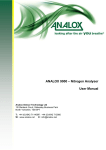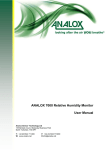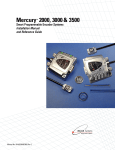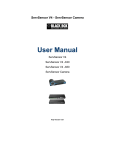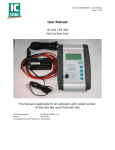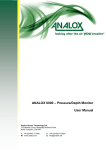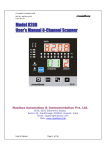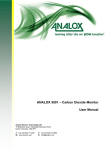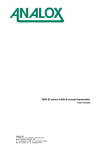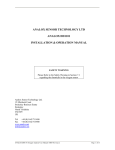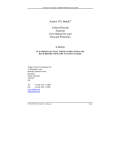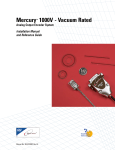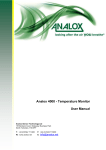Download ANALOX 3000 – Carbon Monoxide Monitor User Manual
Transcript
ANALOX 3000 – Carbon Monoxide Monitor User Manual Analox Sensor Technology Ltd 15 Ellerbeck Court, Stokesley Business Park North Yorkshire, TS9 5PT T: +44 (0)1642 711400 W: www.analox.net F: +44 (0)1642 713900 E: [email protected] Analox 3000 – Carbon Monoxide Monitor – User Manual CONTENTS Introduction ......................................................................................................Page 2 Calibration........................................................................................................Page 3 Alarm Operation...............................................................................................Page 3 Alarm Setting ...................................................................................................Page 4 Battery Backup.................................................................................................Page 5 Interference......................................................................................................Page 5 Installation........................................................................................................Page 5 Rear Panel Connections ..................................................................................Page 6 Power Supply...................................................................................................Page 6 Signal Input/Output ..........................................................................................Page 6 Alarm Relays....................................................................................................Page 7 Repair and Service ..........................................................................................Page 7 Specification (Electrical)...................................................................................Page 8 Specification (Mechanical) ...............................................................................Page 9 Calibration Certificate.....................................................................................Page 10 Disposal .........................................................................................................Page 11 Document Ref: 3KO-810-02 November 2010 Page 1 Analox 3000 – Carbon Monoxide Monitor – User Manual OPERATING INSTRUCTIONS FOR ANALOX 3000 WARNING These instructions should be read and understood by all individuals who will be responsible for operation of this analyser. The actions taken as a result of the measured levels must be in strict accordance with the company and government regulations. INTRODUCTION The ANALOX 3000 Carbon Monoxide Monitor provides a Continuous digital display of Carbon Monoxide concentration measured by a ANALOX 3000si Sensor/Transmitter. The instrument displays the measured value on a 4 ½ Digit red LED configured to read over the range 0-100ppm with a Resolution of 0.1ppm The sensor/transmitter used by the instrument all incorporate ‘state of the art’ advanced electrochemical technology giving high levels of specificity. The sensors communicate with the instrument via a 4 – 20 mA signal loop. The 24-volt DC power for the loop is provided by the ANALOX 3000 instrument. The instrument is easy to calibrate, using the ‘ZERO’ and ‘CAL’ adjustments on the front panel. User adjustable two stage audio/visual alarms, together with relays, are fitted as standard and these may be adjusted over a full range of the instrument. The relay outputs are available on the instrument rear panel. Several power supply options are fitted on all instruments, as standard. Input 1 is a standard IEC 3-pin connector for AC power in the range 85 volts to 264 volts 47 to 63 Hz WITHOUT switching or selecting. Input 2 is a standard coaxial battery charger type connector or a 2 way screw terminal type connector for low voltage power input in the following range. DC 12v to 32v Note: Polarity of connection of DC is important. The internal power supply unit can be fitted with an optional re-chargeable Nickel Cadmium battery, which provides up to 1 hour of normal operation in the event of external power failure. External power status and internal battery condition are indicated by an LED on the front panel. Document Ref: 3KO-810-02 November 2010 Page 2 Analox 3000 – Carbon Monoxide Monitor – User Manual CALIBRATION The instrument and sensor assemblies are fully calibrated before they leave the factory and should not require frequent re-calibration. The 4-20mA-sensor transmitter should not normally require adjustment – any recalibration should be carried out at the Instrument. For details regarding Sensor/Transmitter calibration, refer to the manual for the sensor. To carry out a calibration procedure the following items are required; a) b) c) d) e) d) ‘Zero’ Gas i.e. Nitrogen or clean Air ‘Span’ Gas certified value within the measurement range. A suitable Pressure regulator. A flow meter range 0 – 20 Ltr/Hr ¼ Inch PVC Tubing as required Flow adaptor as supplied with sensor. NOTE: The instrument and sensor should be switched on for at least 15 minutes, before any adjustments are made. Zero Adjustment Fit the flow adaptor to the sensor front assembly and connect this via the flow meter to the pressure regulator and ‘zero’ gas source, using the PVC tubing. Ensure that the adaptor exhausts to atmospheric pressure. If any appreciable pressure builds up at the sensor surface, then incorrect readings will result. Select the ‘HI RES’ range on the instrument adjust the gas flow rate to 200 millilitres/min (12 litres/ Hr) and wait for about 5 minutes. When the ± the last digit) adjust the ‘ZERO’ trimmer on the front panel of the Instrument until the display reads 000.0. Remove the ‘ZERO’ Gas source from the pressure regulator. Span Adjustment Connect the certified gas to the regulator and adjust the flow rate to 200millilitres/min (12 litres/Hr) and wait for about 5 minutes. When the reading on the display is steady, (± the last digit) adjust the ‘CAL’ trimmer on the front panel of the instrument until the display reads the value of the certified gas. Remove the calibration equipment from the sensor including the adaptor, if this is not used during normal operation. This completes the calibration process. IMPORTANT: The Analox sensors, in common with all electrochemical cells of this type, are somewhat sensitive to the flow rate of the particular gas to be measured. It is therefore important that the flow rate is confined within narrow limits. Minimum and maximum recommended flow rates are 150ml / min and 300ml/min respectively. Document Ref: 3KO-810-02 November 2010 Page 3 Analox 3000 – Carbon Monoxide Monitor – User Manual ALARM OPERATION If a first stage alarm condition occurs, the internal audible buzzer will sound intermittently and the yellow ‘HORN’ LED will flash, thereby identifying which instrument is causing the alarm. The red ‘LO’ LED will indicate the alarm level. The audible alarm can then be silenced by pressing the ‘MUTE’ button; this action will also turn of the yellow ‘HORN’ Led. If the reading is still in an alarm condition, the red ‘LO’ LED will continue to flash until the measured value returns within the normal band. The red LED will then turn off. If a second stage alarm condition then occurs, the buzzer will sound continuously and the yellow ‘HORN’ LED will flash, thereby identifying which instrument is causing the alarm. The ‘HI’ LED will indicate the alarm level. The audible alarm may then be silenced by pressing the ‘MUTE’ button; this action will also turn off the yellow ‘HORN’ led. If the reading is still above the ‘HI’ setpoint, the red ‘HI’ LED will continue to flash until the measured value drops below the setpoint. The ‘LO’ alarm condition will still be active until the measured value falls below the ‘LO’ setpoint. If an alarm condition occurs and the measured value then returns to normal before the MUTE button is pressed, then the audible and visual alarms will continue to be active until the MUTE button is pressed. This facility allows the operator to be aware of any alarm occurrence whilst the instrument was unattended. The alarms have a built-in Hysteresis of approximately 3-ppm to overcome ‘nuisance’ triggering when measuring near the setpoints. This means that if an alarm occurs with a set point of 35ppm, then having been acknowledged by pressing the MUTE button, the alarm will not clear until the measured value drops below 32ppm. ALARM SETTING Before any adjustments are made to the ‘SET ALARM’ controls, the operator should release the locks on the knobs. This is done by moving the small lever located at the edge of the control until the knob turns freely. After adjustment, the locks should be reset in order to prevent accidental movement. The ‘SET HI’/‘SET LO’ toggle switch is normally biased to its central position to read the measured value. The high alarm trip point is set by moving this switch upward and adjusting the ‘SET HI ALARM’ control knob until the desired High alarm trip level is displayed. The low alarm trip point is set by moving the switch downward and adjusting the ‘SET LO ALARM’ control knob until the desired level is displayed. If the operator only requires to check the currently set alarm points this may be done by just pressing the ‘SET HI’/‘SET LO’ switch to the appropriate position, and reading the levels on the LED Display. Document Ref: 3KO-810-02 November 2010 Page 4 Analox 3000 – Carbon Monoxide Monitor – User Manual BATTERY BACKUP If the external power supply to the instrument fails, the power supply circuitry in the instrument will automatically change over to the internal battery if fitted. When the instrument is being driven by its internal battery, the green ‘STANDBY’ LED on the front panel will be lit and will remain on until external power is restored. The internal battery will provide normal operation for approximately 1 hour. When the battery has been discharged to such a level that instrument operation below this level would not be reliable, then a trip circuit will turn off the complete instrument and indicates this state by flashing the green ‘STANDBY’ LED at approximately 1 second intervals. INTERFERENCE Whilst all reasonable precautions have been taken within the Instrument circuitry and the case is RF screened, it is still possible, in common with other instruments, that very strong, local radio frequency fields could cause interference. This will show up as erratic readings on the LED Display. Where possible, RF sources such as Portable Radio Transmitters or Telephones should not be operated very close to the instrument. INSTALLATION The 3000 Range of ANALOX instruments are available in two forms: Suitable for insertion in a 19 inch Rack frame, occupying ¼ of a standard 3U frame. Suitable for direct mounting in an existing instrument panel. For details of dimensions, cut outs and mounting centres refer to the mechanical Specifications page at the end of this handbook. The frame-mounting version should be inserted in a suitable rack and secured by the 4 corner screws and plastic brushes, supplied with the Instrument. Refer to connection details below. When fitting the panel mounted version, the nut and retainer assemblies should be left attached to the instrument, as supplied and the whole assembly inserted into the panel, easing the retainers into the 10mm holes. Tightening the 4 screws will expand the retainers, locking them into the panel. If the instrument is subsequently removed from the panel, it is only necessary to remove the screws – the retainers should remain captive in the panel. All Inputs to and Outputs from the instrument are connected via various sockets and terminals on the rear panel of the instrument. All connections are identified by labels on the rear panel but are repeated here for convenience. Document Ref: 3KO-810-02 November 2010 Page 5 Analox 3000 – Carbon Monoxide Monitor – User Manual POWER SUPPLY Power for the instrument may be derived from 1 of 2 options: AC power in the range 85 to 264 VAC, 47 to 63 Hz and connected via a standard IEC 3 pin plug/ socket. A suitable lead is supplied with the instrument. The fuse for this power input is mounted in the rear panel and is rated at 1 Amp ‘T’ type.is input – the instrument will operate from any voltage within the stated range. DC power in the range 12 to 32 VDC THE LOW VOLTAGE DC SUPPLY SHOULD BE EXTERNALLY FUSED at a rating of 1 Amp using a ‘T’ delay fuse. Low Voltage D.C. in the range 12v to 32v with a ripple not exceeding 1 volt and connected via the battery charger type connector or the 2 way screw terminal type connector. SIGNAL INPUTS AND OUTPUTS. All signal inputs and outputs are made to be removable, screw terminal plugs. The main connector is located down on the right side of the rear panel, when viewed from the rear. Several signal-input options are fitted to the instruments. In the case of the 3000 Instrument, the sensor transmitter should be connected to terminals 14 and 18. Pin 18 is the sensor transmitter excitation voltage and should be connected to the positive terminal of the transmitter. NOTE: Ensure that there is NO LINK between terminals 15 and 16 – this is only fitted when the instrument is used with a voltage input. Other signal inputs are not used on the 3000 Instrument. Two analogue outputs, proportional to the measured input signal are available from the instrument. Pin 8 provides 0-1 Volt representing 0-1000ppm CO, Pin 9 provides a 4-20mAmp current representing 0-1000ppm CO. Pin 7 is the common connection for both outputs. The voltage output should NOT be connected to a load less than 10.000 Ohms. The current output is powered from an internal nominal 24-Volt supply and can operate into a load from 50 Ohms to 500 Ohms. Document Ref: 3KO-810-02 November 2010 Page 6 Analox 3000 – Carbon Monoxide Monitor – User Manual ALARM RELAYS Two relays can be fitted as an optional extra which operate in conjunction with the HI and LO alarms. The relays have single pole changeover contact arrangements, rated to switch up to7 amps @240v AC or 30v DC The relays may be configured to be energised or de-energised, when the Instrument is in a non-alarm state. If the relays are configured to be a normally energised state, this will provide a ‘Fail- Safe’ facility in that a total power failure will cause the relays to release and signal an alarm condition. However, the extra power drawn by the relays being energised for most of the time will reduce the time for which the Instrument will operate on ‘Battery Backup’. Contact arrangement is shown on the rear panel. Instruments normally leave the factory with the relays configured to ENERGISE IN ALARM conditions. REPAIR AND SERVICE Apart from periodic calibration, the instrument has been designed to provide long, trouble free service. However, in the event of a fault condition arising, contact your local distributor or Analox Technology Ltd, Whose address, telephone, telefax and email numbers appear on the front page of this handbook. The instrument contains complex, precision circuitry, which requires special test equipment to ensure correct internal set-up and calibration. Internal repairs or adjustments by the user are therefore NOT recommended. A separate service manual may be purchased by approved service centres, from Analox Technology Ltd. ANALOX SENSOR TECHNOLOGY LTD WILL NOT ACCEPT RESPONSIBILITY FOR ANY EVENTS OCCURING AS A RESULT OF UNAUTHORISED ADJUSTMENTS OR REPAIRS TO THE INSTRUMENT. Document Ref: 3KO-810-02 November 2010 Page 7 Analox 3000 – Carbon Monoxide Monitor – User Manual ANALOX 3000 SPECIFICATION ELECTRICAL Range Resolution 0.0 – 100.0ppm Carbon Monoxide HIGH 1 ppm LOW 0.1ppm Electronic Accuracy ± 0.02% Full Scale Power Supply Options 85v to 264 VAC 47 to 63 Hz Without switching 12v to 32v D.C. Max Ripple 1v Outputs 0 – 1 Volt for Chart recorder 4 – 20mA Internally powered - Optional Internal Battery 5 Volt 1.4AH Nickel Cadmium Backup time Approx. 1 hour Optional Alarm Relays 2x Single Pole Changeover Rated 7 amp 240v A.C. 30v D.C. Configurable to be energised or de-energised when in Non-Alarm condition. Document Ref: 3KO-810-02 November 2010 Page 8 Analox 3000 – Carbon Monoxide Monitor – User Manual ANALOX 3000 SPECIFICATION MECHANICAL Dimension Rack mounted version Depth overall 245mm Height overall 129mm Width overall 10 7mm (1/4 19” x 3U Rack) Weight 2 Kg Panel Mounted Version Depth Overall 245mm Height 133mm Width Overall 120mm Weight 2 Kg Panel Cut-out Aperture Height 112mm Width 102mm Mounting Centres 4 x 10mm Holes Height 122.5mm Width 91.4mm Centred on Cut-out Environmental Operating Temp. Storage Temp. Relative Hum. Non Condensing 0 – 60 °C – 40 to + 85 °C 95% at 40 °C Document Ref: 3KO-810-02 November 2010 Page 9 Analox 3000 – Carbon Monoxide Monitor – User Manual CALIBRATION CERTIFICATE INSTRUMENTAL SERIAL: …………………………… DATE:………………… SENSOR SERIAL:……………………………. NOTE: No calibration Adjustments are permitted during this procedure. TIME (MINUTES) INITIAL GAS 5 10 15 30 45 60 CHANGE GAS 5 10 15 30 45 60 CHANGE GAS 5 10 15 CHANGE GAS 5 10 15 GAS FLOW RATE READING Signed:…………………………………………..…… Print:………………………………………………….. Document Ref: 3KO-810-02 November 2010 Page 10 Analox 3000 – Carbon Monoxide Monitor – User Manual DISPOSAL According to WEEE regulation this electronic product can not be placed in household waste bins. Please check local regulations for information on the disposal of electronic products in your area. Document Ref: 3KO-810-02 November 2010 Page 11












